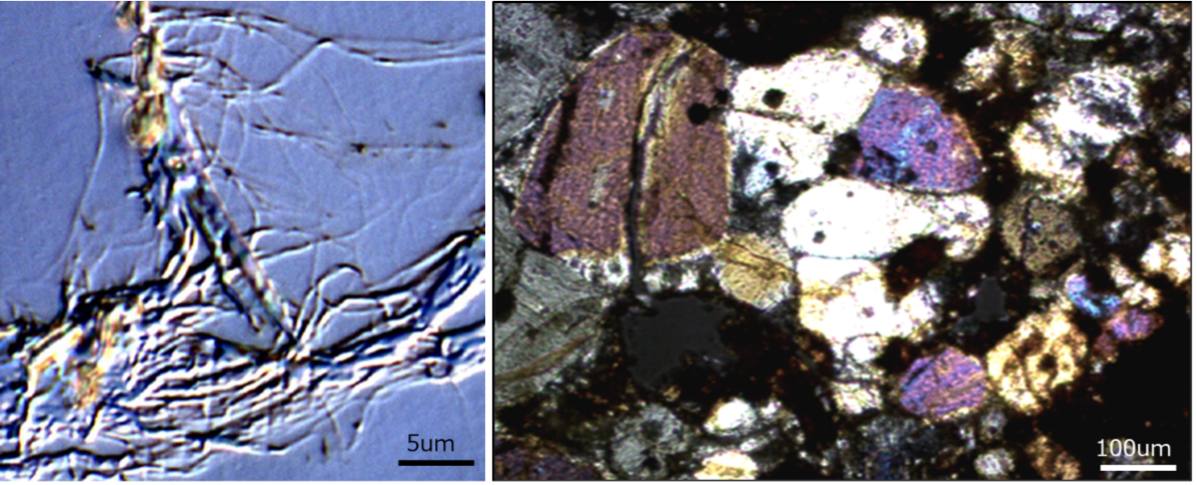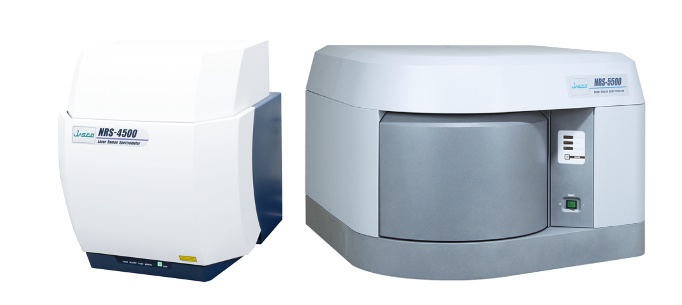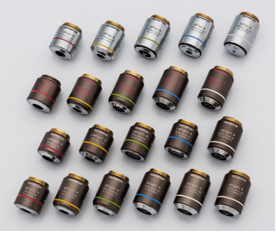Clearly Visualizing Sample Colors, Scratches, Defects, and Irregularities
In materials sciences applications, UIS2 objective lenses enable microscope users to clearly visualize the color of the sample, scratches and defects on the surface, and surface irregularities. They enhance the optical performance of our systems, such as the BX53M microscope, improving the efficiency of our customers’ work. Interestingly, but perhaps not surprisingly, our wide range of industrial and biological UIS2 objectives have also been incorporated into a number of devices designed by manufacturers outside of Evident.

Differential interference contrast (DIC) observation of a carbon nanotube (CNT) and polarization observation of minerals
Impacting Optical Technology Development and Performance Beyond Our Walls
JASCO Corporation is one example. They use our objective lenses in its Raman spectroscopy products, which are commonly used for materials analysis. JASCO Corporation is a global company, headquartered in Japan. Since its founding in 1958, it has developed, manufactured, and sold optical analysis equipment and developed analysis services.
JASCO Corporation has adopted our UIS2 objective lenses for various Raman spectroscopy systems, for example, its laser Raman spectrophotometer as NRS-4500, NRS-5500, and NRS-7500. These instruments, which have built-in UIS2 objective lenses, are capable of high-performance and highly accurate Raman measurement. They can be used to perform not only qualitative analysis but also identification and mapping of multilayered samples, particulate identification, and chemical distribution.
UIS2 objective lenses with infinity-corrected optics ease the optical design of equipment since switching between magnifications and adding components to the infinity space are all possible, an aspect which has been particularly well received by engineers designing scientific instruments. Mr. Tsutomu Inoue of JASCO Corp’s Raman system division, explains what benefits UIS2 objective lenses have brought to the company’s instrument design:
UIS2 objective lenses are designed with an infinity correction optical system. Even if the objective lens is switched using the revolving mechanism, the focal position of the laser spot is maintained. Inserting optical components, such as a polarizer or a wave plate, into the optical path does not cause the laser spot to shift position. Therefore, even if you switch from optical observation to Raman measurement, you can measure the target position.

Difference between an infinity-corrected optical system (left) and a finite-corrected system (right)
Developing the Analyzer Business through Collaboration
In addition to our high-quality optics, Mr. Inoue explains that Evident’s support services also play a key role in developing Raman spectrometry products. "Our customers’ demands for products for observation as well as analysis applications have been increasing year after year. Observation methods such as brightfield, darkfield, polarization, and differential interference contrast (DIC) of microscopes have become indispensable for microscopic analysis. For detailed analysis of the sample, it is important to integrate not only the Raman spectrum but also various information such as accurate size, shape, color, and fluorescent elements. We often consult Evident support staff about unique observation applications and are very satisfied with the wide range of solutions proposed by them, including additional units and customization. We also have the advantage that our development facilities are within walking distance, so we will continue to collaborate with Evident, and we would like to continue developing our relationship even further.”
For more information on integrating our high-quality optical components into your instrument design, visit www.olympus-lifescience.com/oem-components/.
For more information on JASCO Corporation, go to https://www.jasco-global.com.
Related Content
Using Image Analysis Software to Automatically Detect Particles in Cadmium Zinc Telluride
Webinar: Fluorescence Microscopy and Its Applications in Industry




